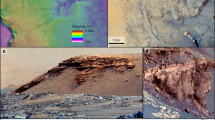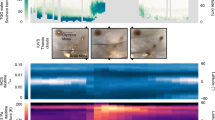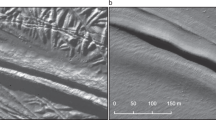Abstract
Unlike Earth, where astronomical climate forcing is comparatively small, Mars experiences dramatic changes in incident sunlight that are capable of redistributing ice on a global scale1,2,3,4,5,6. The geographic extent of the subsurface ice found poleward of approximately ±60° latitude on both hemispheres of Mars7,8,9 coincides with the areas where ice is stable7,10,11. However, the tilt of Mars’ rotation axis (obliquity) changed considerably in the past several million years. Earlier work3,12 has shown that regions of ice stability, which are defined by temperature and atmospheric humidity, differed in the recent past from today’s, and subsurface ice is expected to retreat quickly when unstable11,12,13. Here I explain how the subsurface ice sheets could have evolved to the state in which we see them today. Simulations of the retreat and growth of ground ice as a result of sublimation loss and recharge reveal forty major ice ages over the past five million years. Today, this gives rise to pore ice at mid-latitudes and a three-layered depth distribution in the high latitudes of, from top to bottom, a dry layer, pore ice, and a massive ice sheet. Combined, these layers provide enough ice to be compatible with existing neutron and gamma-ray measurements7,8,9.
This is a preview of subscription content, access via your institution
Access options
Subscribe to this journal
Receive 51 print issues and online access
$199.00 per year
only $3.90 per issue
Buy this article
- Purchase on Springer Link
- Instant access to full article PDF
Prices may be subject to local taxes which are calculated during checkout



Similar content being viewed by others
References
Toon, O. B., Pollack, J. B., Ward, W., Burns, J. A. & Bilski, K. The astronomical theory of climate change on Mars. Icarus 44, 552–607 (1980)
Jakosky, B. M. & Carr, M. H. Possible precipitation of ice at low latitudes of Mars during periods of high obliquity. Nature 315, 559–561 (1985)
Mellon, M. T. & Jakosky, B. M. The distribution and behavior of Martian ground ice during past and present epochs. J. Geophys. Res. 100, 11781–11799 (1995)
Mischna, M. A., Richardson, M. I., Wilson, R. J. & McCleese, D. J. On the orbital forcing of martian water and CO2 cycles: A general circulation model study with simplified volatile schemes. J. Geophys. Res. E 108 5062 doi: 10.1029/2003JE002051 (2003)
Levrard, B., Forget, F., Montmessian, F. & Laskar, J. Recent ice-rich deposits formed at high latitudes on Mars by sublimation of unstable equatorial ice during low obliquity. Nature 431, 1072–1075 (2004)
Forget, F., Haberle, R. M., Montmessin, F., Levrard, B. & Head, J. W. Formation of glaciers on Mars by atmospheric precipitation at high obliquity. Science 311, 368–371 (2006)
Boynton, W. V. et al. Distribution of hydrogen in the near-surface of Mars: evidence for subsurface ice deposits. Science 297, 81–85 (2002)
Feldman, W. C. et al. Global distribution of neutrons from Mars: results from Mars Odyssey. Science 297, 75–78 (2002)
Mitrofanov, I. G. et al. Maps of subsurface hydrogen from the high-energy neutron detector, Mars Odyssey. Science 297, 78–81 (2002)
Mellon, M. T., Feldman, W. C. & Prettyman, T. H. The presence and stability of ground ice in the southern hemisphere of Mars. Icarus 169, 324–340 (2004)
Schorghofer, N. & Aharonson, O. Stability and exchange of subsurface ice on Mars. J. Geophys. Res. 110 E05003 doi: 10.1029/2004JE002350 (2005)
Mellon, M. T. & Jakosky, B. M. Geographic variations in the thermal and diffusive stability of ground ice on Mars. J. Geophys. Res. 98, 3345–3364 (1993)
Hudson, T. L. et al. Water vapor diffusion in Mars subsurface environments. J. Geophys. Res. 112 E05016 doi: 10.1029/2006JE002815 (2007)
Leighton, R. B. & Murray, B. C. Behavior of carbon dioxide and other volatiles on Mars. Science 153, 136–144 (1966)
Prettyman, T. H. et al. Composition and structure of the Martian surface at high southern latitudes from neutron spectroscopy. J. Geophys. Res. 109 E05001 doi: 10.1029/2003JE002139 (2004)
Mellon, M. T., Jakosky, B. M. & Postawko, S. E. The persistence of equatorial ground ice on Mars. J. Geophys. Res. 102, 19357–19369 (1997)
Laskar, J. et al. Long term evolution and chaotic diffusion of the insolation quantities of Mars. Icarus 170, 343–364 (2004)
Ward, W. R. Climatic variations on Mars I. Astronomical theory of insolation. J. Geophys. Res. 79, 3375–3386 (1974)
Litvak, M. L. et al. Comparison between polar regions of Mars from HEND/Odyssey data. Icarus 180, 23–37 (2006)
Feldman, W. C. et al. The global distribution of near-surface hydrogen on Mars. J. Geophys. Res. 109 E09006 doi: 10.1029/2003JE002160 (2004)
Feldman, W. C. et al. Vertical distribution of hydrogen at high northern latitudes on Mars: The Mars Odyssey Neutron Spectrometer. Geophys. Res. Lett. 34 L05201 doi: 10.1029/2006GL028936 (2007)
Mustard, J. F., Cooper, C. D. & Rifkin, M. K. Evidence for recent climate change on Mars from the identification of youthful near-surface ground ice. Nature 412, 411–414 (2001)
Head, J. W., Mustard, J. F., Kreslavsky, M. A., Milliken, R. E. & Marchant, D. R. Recent ice ages on Mars. Nature 426, 797–802 (2003)
Laskar, J., Levrard, B. & Mustard, J. F. Orbital forcing of the martian polar layered deposits. Nature 419, 375–377 (2002)
Schorghofer, N. Theory of ground ice stability in sublimation environments. Phys. Rev. E 75, 041201 (2007)
Acknowledgements
I thank O. Aharonson and B. Jakosky for discussions and E. Pilger for computing help. This material is based upon work supported by the NASA Astrobiology Institute.
Author information
Authors and Affiliations
Corresponding author
Ethics declarations
Competing interests
Reprints and permissions information is available at www.nature.com/reprints. The author declares no competing financial interests.
Rights and permissions
About this article
Cite this article
Schorghofer, N. Dynamics of ice ages on Mars. Nature 449, 192–194 (2007). https://doi.org/10.1038/nature06082
Received:
Accepted:
Published:
Issue Date:
DOI: https://doi.org/10.1038/nature06082
This article is cited by
-
Cold-based glaciation of Pavonis Mons, Mars: evidence for moraine deposition during glacial advance
Progress in Earth and Planetary Science (2020)
-
Formation of recurring slope lineae on Mars by rarefied gas-triggered granular flows
Nature Geoscience (2017)
Comments
By submitting a comment you agree to abide by our Terms and Community Guidelines. If you find something abusive or that does not comply with our terms or guidelines please flag it as inappropriate.



